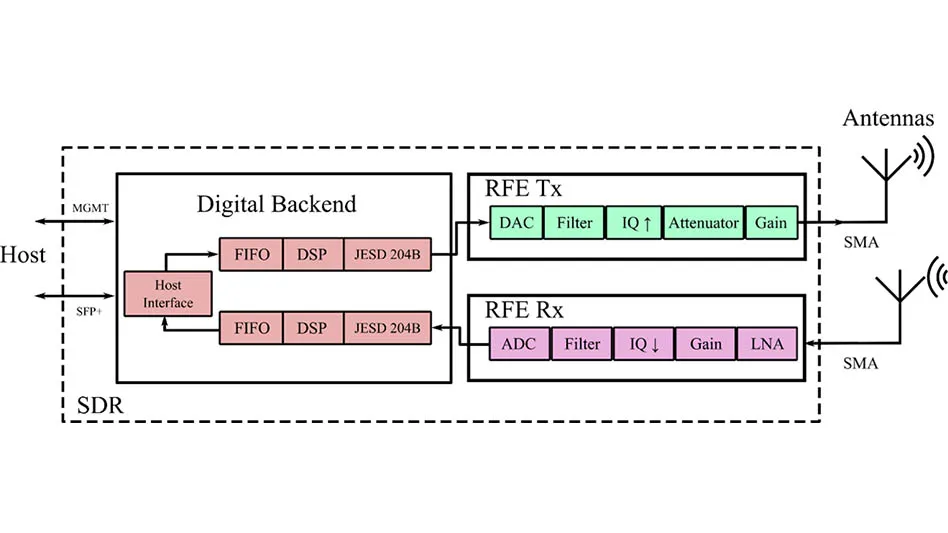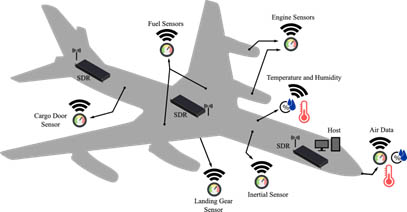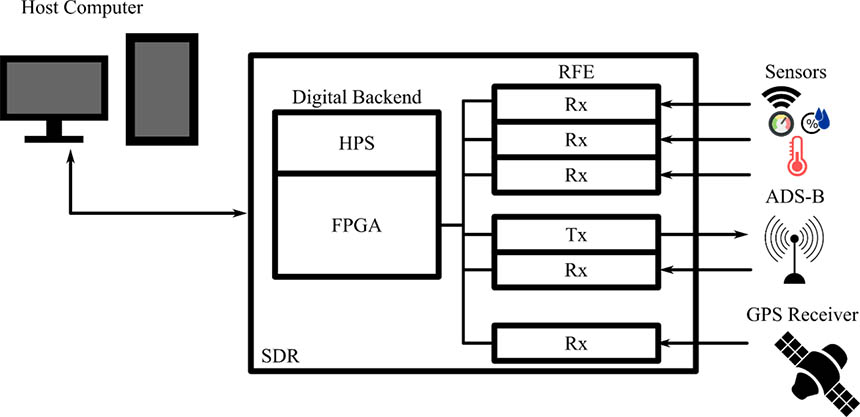
Credit all images: Per Vices
Introduction
Modern aircraft are extremely technological vehicles that incorporate several wireless sensors for a variety of functionalities, including connected logistics, predictive maintenance, health monitoring, and asset tracking. These sensors are fundamental to ensure safety, effectiveness, and proper functioning of the aircraft, so the RF links between sensors and control unit must be reliable, deterministic, and well-defined. It is crucial to provide enough programmability and reconfigurability to support state-of-the-art communication standards, efficient spectrum usage, and adaptative operation to address a variety of scenarios.
In this article, we discuss the role of software-defined radios (SDRs) in the development of avionic sensor systems, such as radio frequency (RF) testbeds and wireless gateways, for the several radio protocols, frequencies, and modulations associated with each sensor device. Moreover, we present the many benefits of implementing SDRs in these sensor systems, including improvement of the SWaP (Size, Weight, and Power) load – which is fundamental to reduce tonnage and increasing fuel economy; acceleration of development and deployment of new systems; and easier integration with newer technologies and legacy systems, by implementing application-agnostic SDRs.
What is an SDR?
Before diving deeper into avionic applications, let’s discuss a little bit more about SDRs. As shown in Figure 1 above, SDRs are RF transceivers composed of two main building blocks: the radio front-end (RFE) and the digital backend. The RFE contains all analog components required for the basic Tx and Rx functionalities, including signal amplification, filtering, noise reduction, and antenna coupling. High-end RFEs provide several channels with independent ADC/DACs, to convert the signal into the digital domain for further processing.
The digital backend is typically composed of an FPGA with on-board DSP capabilities, including modulation, demodulation, up/down-converting, data packaging, and serial interfacing with analog modules. The FPGA also provides a programmable environment for embedded communication protocols and application-specific algorithms, including artificial intelligence (AI), encryption, and cognitive radio. The programmability of the FPGA allows the system to be completely reconfigured without any hardware modification, enabling the repurposing of systems and adaptative operation to address different scenarios. The SDR architecture displayed in Figure 1 facilitates modular design to comply with different SWaP and performance requirements. SDRs can be either applied as standalone devices or paired with a host system, which allows remote configuration of RF parameters, control of the communication protocol, and data processing.
Challenges with current avionics systems
Although sensor devices are a fundamental part in any aerospace vehicle, they introduce several challenges in avionics design. One of the major issues in conventional systems is the huge number of cables necessary for interconnection, powering, and communication. Cables are a problem in avionics, as they significantly increase the vehicle weight and limit the available space, which decreases the capacity for profitable payloads. Moreover, they increase the design complexity and maintenance demand, increasing development time, and long-term cost. Cables are also very noisy antennas, especially communication wires carrying high-frequency signals, so they can cause interference with on-board RF devices and create electromagnetic signatures that can be detected by enemy aircraft. ´
Besides the problematic cable requirements, conventional avionic RF systems, including communication, navigation, and surveillance (CNS), are quite inefficient in terms of spectrum usage, which can lead to channel saturation when more advanced technologies - with higher throughput and bandwidth - are implemented.
Another limitation of conventional RF systems is the inability to be upgraded and adapted to a certain application without major hardware replacements. This goes against the current aircraft design paradigms, that don’t shy away from expending large amounts of money to develop highly efficient and robust vehicles. The use of hardware-based radios in these aircraft would greatly undermine their true potential, so software-defined communication systems are the best approach in these scenarios. The implementation of flexible and programmable SDRs, that can be reconfigured in real-time without hardware modification, is fundamental to allow easy integration of new sensors, real-time tuning of the RF parameters to improve spectrum efficiency, and application of state-of-the-art protocols and algorithms for security, robustness, and error correction.
How SDRs can be used to solve these challenges
The major advantage of using SDRs as the main building blocks of the sensor network architecture is the elimination of most of the transmission cables, relying almost completely on wireless communication between the sensors and the control unit. This way, sensors can be added and removed without requiring hardware modification at the physical layer. Furthermore, this approach greatly reduces the total weight of the network, increasing the payload capability of the aircraft and improving the fuel economy. In this context, SDRs can act as gateways to the distributed sensors, controlling the information flow between the many wireless equipment and the sensors. In this process, each sensor sends a data package containing measurement information to the central hub, which then sends the sensor data to the flight computer designated to this sensor. The computer can subscribe to a sensor before take-off and request information during the flight, providing situational awareness in real-time. Figure 2 shows a typical structure for a software-based avionics network with several wireless sensors.

The ability of SDRs to rapidly adapt to new and changing modulation schemes and communication protocols – via software – allows the fast integration of sensors to the network backbone, as off-the-shelf wireless sensors can be added to the vehicle without major changes to the aircraft structure. All it requires is the configuration of the SDR to comply with the sensor RF requirements and the assignment of the sensor to the main network, which can be done through the host computer. Although the initial investment in high-end SDRs may be large, the reduction of development time combined with the elimination of cables greatly reduces the total cost and maintenance requirements of the network, providing a more economical approach in the long run. The wireless approach also reduces the time-to-market of new sensors and devices, as a novel wireless sensor can be immediately integrated into already existing commercial aircraft as soon as its performance is validated in research vehicles. Finally, SDR-based gateways can ensure that sensor subscription occurs only before take-off, which increases safety by protecting the network against malicious access and interference during the flight.
SDRs can be completely reprogrammed and repurposed on-the-fly, without any hardware replacement. This results in a single SDR able to support several different protocols, modulation schemes, and frequencies, allowing the vehicle to be constantly upgraded to the latest protocols without modifying the backbone of the network architecture. This upgradability also enables existing aircraft to be compatible with future developments in spectrum efficiency, which is a major target in avionics development. SDRs allow near real-time reconfiguration of the RFE channels, including gain and filtering, which provides a higher level of flexibility to the network controller, enabling the implementation of adaptative algorithms, such as automatic gain control and adjacent channel rejection. Finally, the same SDR can be used to perform multiple tasks, such as acting as a transponder or a GPS receiver, which eliminates the need for dedicated equipment, improving interoperability and reducing complexity.

Conclusion
Avionic sensors are a fundamental part of modern aerospace technology, as they provide the situational awareness and feedback required to maximize safety and efficiency. In a sensor network, the main computer and control devices request measurements for the many sensors of the aircraft, including pressure, flow, temperature, position, force, and vibration. These communication lines are conventionally implemented using cables, which greatly impacts the total weight of the aircraft and reduces the payload capability. The RF behavior of cables also make them prone to interference and malicious detection. Hardware-based communication systems also cannot be easily upgraded – often requiring major physical modifications for maintenance and sensor integration – and are limited in terms of spectrum efficiency. By using SDRs as gateways for avionic sensors, the cable problem is eliminated, thus improving the payload capability and fuel efficiency. Furthermore, engineers can easily integrate new sensors and novel algorithms into the network without any hardware modification, improving security, spectrum efficiency, and time-to-market. SDRs can also be reprogrammed to act as dedicated RF devices, reducing the total equipment count, cost, and complexity. With the fast development and standardization of the Internet of Things (IoT) and 5G devices, SDR gateways are going to be fundamental in supporting the new generation of avionic sensors.
Per Vices
https://www.pervices.com
About the company: Per Vices has extensive experience in designing, developing, building, and integrating SDRs for various applications. Visit the website for help with your SDR needs.
Latest from Aerospace Manufacturing and Design
- Aura Aero selects Florida manufacturing, assembly site
- EMUGE-FRANKEN's high performance end mills
- IMTS 2024 Booth Tour: Engis Corporation
- How can we make electric vehicles more user-friendly?
- Leaders in Manufacturing webinar will ease your fears about changes in the industry
- October Lunch + Learn with EMUGE-FRANKEN USA and Okuma America
- October Lunch + Learn with SMW Autoblok
- marcus evans announces the Aerospace & Defense Manufacturing and R&D Summit 2024





